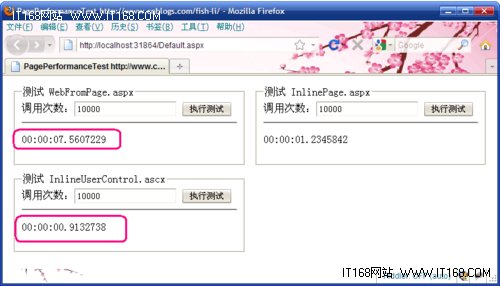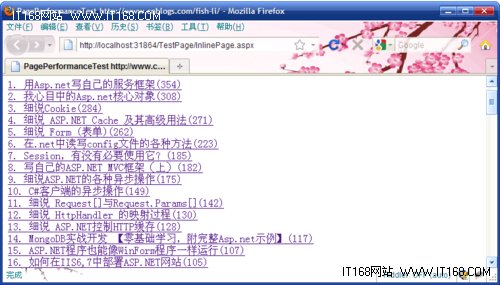ASP.NET页面性能提升8倍的优化方法
第1页:
【IT168 技术】阅读目录
开始
测试背景
测试方法
测试用例1:WebFromPage.aspx
测试用例2:InlinePage.aspx
分析优化结果1
测试用例3:InlineUserControl.ascx
分析优化结果2
今天与大家分享:一种优化页面执行速度的方法。采用这个方法,可以使用页面的执行速度获得【8倍】的提升效果。为了让您对优化的效果有个直观的了解,我准备了下面的测试结果截图:
|
测试环境:
1. Windows Server 2003 SP2
2. Viaual Studio 2008,使用自带的WebDev.WebServer.EXE运行网站程序。
3. (ThinkPad SL510):Core2 T6670 2.2GHz, 4G内存
二个红框中的数字反映了优化前后的执行时间。
数字表明:优化前后,执行时间有了8倍多的差别。
本文的测试结果也仅仅只是一个参考数字,这个结果也只是根据我所设计的测试页面得出的。优化的过程中,如果不使用服务器控件,那么给GC减少的压力其实也是无法测试到的.在测试过程中,我还发现测试结果并不是很稳定,因此截图具有一定的偶然性。
测试页面或许在某些方面存在一些片面性,因此,结果仅供参考。看过了优化结果,再来介绍一下:这个测试到底是在测试什么东西?
现在有很多做ASP.NET的开发人员,应该都是从ASP.NET的WebForm编程模型开始学习的。 大家都很喜欢用服务器控件,不管输出什么,都会使用服务器控件。 有时候为了让页面呈现干净的HTML代码,有些人会选择使用Repeater,Literal这类简单的服务器控件。 或许有些人认为:我已不使用GridView这样强大复杂的控件,页面执行速度已经很快了。
真是这样吗?今天测试的起点就从使用简单的服务器开始,我会分二次对它做一系列的性能优化。
最终就是上图中的3个结果,它们反映了二次优化的改进过程。在继续介绍之前,有一点我想有必要说明一下:
优化的过程涉及到ASP.NET服务器控件的使用,测试结果也仅仅只是一个参考数字。
如果您认为您的开发工作非常依赖于服务器控件的使用,
那么测试结果对您来说其实是无意义的,请不要在意这个结果。
测试方法
在这次优化过程中,我并没有设计很复杂的测试页面,而是一个很简单的测试页面,页面显示效果如下:
|
这个页面其实就是显示了一堆超链接,它们来自于我的博客侧边栏的【推荐排行榜】,总共有20条记录, 我让页面重复5次输出,也就是生成了100个超链接。
测试的数据是这样获取的:
我复制了我的博客侧边栏的【推荐排行榜】的那段HTML代码,保存到一个文件中:
|
然后,网站在初始化时,从这段HTML代码提取链接地址以及显示文字,保存到一个BlogInfo的列表中,代码如下:
public class BlogInfo
public string Title;
public string Href;
public static class XmlDb
public static List Blogs { get; private set; }
public static void LoadBlogs()
string filePath = Path.Combine(HttpRuntime.AppDomainAppPath, @App_DataRecommendList.html);
XElement html = XElement.Parse(System.IO.File.ReadAllText(filePath));
Blogs =
(from a in html.Elements(li).Elements(a)
我想这个测试还是比较接近于现实开发的。
这里又有一个问题:我如何测试页面的执行速度?
虽然说创建HttpWebRequest访问页面是个很简单的方法,但我并不打算这样做。
因为从HttpWebRequest发起调用到获取结果,这其中除了有页面的执行时间,还混杂较多的额外调用开销。 最终,我选择了在一次HTTP请求中,循环调用Server.Execute来执行页面,并统计时间的方式。 其实如何选择测试方法,对于二个测试对象还说,都是公平的。 只是说:尽量减少一些额外的调用开销,会让测试结果的差异更大,也更明显。
说明:为了测试代码写起来简单,我使用了MyMVC框架。
测试用例1:WebFromPage.aspx
前面介绍了测试背景以及测试方法。现在就来介绍第1个测试用例,它采用了WebForm编程模型中最经典的写法。
页面代码:
%@ Page Language=C# CodeFile=WebFromPage.aspx.cs Inherits=TestPage_WebFromPage %>
html xmlns=http://www.w3.org/1999/xhtml>
head>
title>PagePerformanceTest http://www.cnblogs.com/fish-li/title>
head>
body>
p>This is WebFromPage.aspxp>
asp:Repeater runat=server onitemdatabound=repeater1_ItemDataBound>
ItemTemplate>
asp:HyperLink runat=server>asp:HyperLink>br />
ItemTemplate>
FooterTemplate>hr />FooterTemplate>
asp:Repeater>
asp:Repeater runat=server onitemdatabound=repeater1_ItemDataBound>
ItemTemplate>
asp:HyperLink runat=server>asp:HyperLink>br />
ItemTemplate>
FooterTemplate>hr />FooterTemplate>
asp:Repeater>
asp:Repeater runat=server onitemdatabound=repeater1_ItemDataBound>
ItemTemplate>
asp:HyperLink runat=server>asp:HyperLink>br />
ItemTemplate>
FooterTemplate>hr />FooterTemplate>
asp:Repeater>
asp:Repeater runat=server onitemdatabound=repeater1_ItemDataBound>
ItemTemplate>
asp:HyperLink runat=server>asp:HyperLink>br />
ItemTemplate>
FooterTemplate>hr />FooterTemplate>
asp:Repeater>
asp:Repeater runat=server onitemdatabound=repeater1_ItemDataBound>
ItemTemplate>
asp:HyperLink runat=server>asp:HyperLink>br />
ItemTemplate>
FooterTemplate>hr />FooterTemplate>
asp:Repeater>
body>
html>
页面的CodeFile代码:
public partial class TestPage_WebFromPage : System.Web.UI.Page
protected override void OnLoad(EventArgs e)
base.OnLoad(e);
repeater1.DataSource = XmlDb.Blogs;
repeater1.DataBind();
repeater2.DataSource = XmlDb.Blogs;
repeater2.DataBind();
repeater3.DataSource = XmlDb.Blogs;
repeater3.DataBind();
repeater4.DataSource = XmlDb.Blogs;
repeater4.DataBind();
repeater5.DataSource = XmlDb.Blogs;
repeater5.DataBind();
protected void repeater1_ItemDataBound(object sender, RepeaterItemEventArgs e)
BlogInfo blog = e.Item.DataItem as BlogInfo;
HyperLink link1 = e.Item.FindControl(link1) as HyperLink;
link1.NavigateUrl = blog.Href;
link1.Text = blog.Title;
测试代码:
[Action]
public object Test1(string callTimes)
int count = 0;
int.TryParse(callTimes, out count);
return count;
HttpContext context = HttpContext.Current;
// 先执行一次,排除编译时间
string html = MyMVC.PageExecutor.Render(context, /TestPage/WebFromPage.aspx, null);
Stopwatch watch = Stopwatch.StartNew();
for( int i = 0; i count; i++ )
html = MyMVC.PageExecutor.Render(context, /TestPage/WebFromPage.aspx, null);
watch.Stop();
return watch.Elapsed.ToString();
当我测试执行10000次时,耗时:00:00:07.5607229
测试用例2:InlinePage.aspx
与测试用例1不同,测试用例2则完全不使用服务器控件。
页面代码:
%@ Page Language=C# %>
html xmlns=http://www.w3.org/1999/xhtml>
head>
title>PagePerformanceTest http://www.cnblogs.com/fish-li/title>
head>
body>
p>This is InlinePage.aspxp>
% foreach( BlogInfo b in XmlDb.Blogs ) { %>
a href= target=_blank>%= b.Title %>a>br />
% } %>
hr />
% foreach( BlogInfo b in XmlDb.Blogs ) { %>
a href= target=_blank>%= b.Title %>a>br />
% } %>
hr />
% foreach( BlogInfo b in XmlDb.Blogs ) { %>
a href= target=_blank>%= b.Title %>a>br />
% } %>
hr />
% foreach( BlogInfo b in XmlDb.Blogs ) { %>
a href= target=_blank>%= b.Title %>a>br />
% } %>
hr />
% foreach( BlogInfo b in XmlDb.Blogs ) { %>
a href= target=_blank>%= b.Title %>a>br />
% } %>
hr />
body>
html>
测试代码:
第2页:测试代码:
[Action]
public object Test2(string callTimes)
int count = 0;
int.TryParse(callTimes, out count);
return count;
HttpContext context = HttpContext.Current;
// 先执行一次,排除编译时间
string html = MyMVC.PageExecutor.Render(context, /TestPage/InlinePage.aspx, null);
Stopwatch watch = Stopwatch.StartNew();
for( int i = 0; i count; i++ )
html = MyMVC.PageExecutor.Render(context, /TestPage/InlinePage.aspx, null);
watch.Stop();
return watch.Elapsed.ToString();
当我测试执行10000次时,耗时:00:00:01.2345842
分析优化结果1
测试用例1执行相同次数所花费的时间是测试用例2的6倍,为什么会这样呢?
为了回答这个问题,我们首先要知道前面二个页面在执行时,它们是如何运行的。
说到这里,就不得不谈ASP.NET的页面编译方式了。ASP.NET的页面编译过程是个复杂的操作,其实我们可以不用关心页面是如何编译的,
但要知道:页面编译后是什么样的。
为了能直观地了解页面编译后的样子,我编译了整个网站,并生成到一个DLL文件中, 然后使用Reflector.exe来分析这个DLL的源代码。
将网站编译成一个DLL文件有二个方法:
1. 安装WebDeployment插件。
2. 使用我的工具:FishAspnetTool
本文将使用FishAspnetTool来编译测试网站获得编译后的DLL文件。
FishAspnetTool是什么?
FishAspnetTool是我在使用Visual Web Developer 2005时,为了方便编译网站而写的一个小工具。
下载地址:http://www.cnblogs.com/fish-li/archive/2011/10/30/2229497.html
注意:下载的是一个工具包,安装后,从开始菜单中运行FishToolsFishAspnetTool即可。
下面是工具的运行截图。
|
操作方法:
1. 点击粉色按钮,选择网站路径。
2. 单选按钮选择第2项。
3. 点击【发布网站】按钮。
在编译网站之后,我就可以知道网站在运行时如何运行页面了。
测试用例1的页面,最后被编译成这样了:
namespace ASP
using System;
using System.Diagnostics;
using System.Runtime.CompilerServices;
using System.Web;
using System.Web.UI;
using System.Web.UI.WebControls;
[CompilerGlobalScope]
public class testpage_webfrompage_aspx : TestPage_WebFromPage, IHttpHandler
private static object __fileDependencies;
private static bool __initialized;
[DebuggerNonUserCode]
public testpage_webfrompage_aspx()
base.AppRelativeVirtualPath = ~/TestPage/WebFromPage.aspx;
if (!__initialized)
string[] virtualFileDependencies = new string[] { ~/TestPage/WebFromPage.aspx, ~/TestPage/WebFromPage.aspx.cs };
__fileDependencies = base.GetWrappedFileDependencies(virtualFileDependencies);
__initialized = true;
base.Server.ScriptTimeout = 0x1c9c380;
[DebuggerNonUserCode]
private void __BuildControl__control10(Control __ctrl)
IParserAccessor accessor = __ctrl;
accessor.AddParsedSubObject(new LiteralControl());
[DebuggerNonUserCode]
private void __BuildControl__control11(Control __ctrl)
IParserAccessor accessor = __ctrl;
accessor.AddParsedSubObject(new LiteralControl( ));
HyperLink link = this.__BuildControl__control12();
accessor.AddParsedSubObject(link);
accessor.AddParsedSubObject(new LiteralControl(
));
[DebuggerNonUserCode]
private HyperLink __BuildControl__control12()
HyperLink link = new HyperLink {
TemplateControl = this
};
link.ApplyStyleSheetSkin(this);
link.ID = link1;
return link;
[DebuggerNonUserCode]
private void __BuildControl__control13(Control __ctrl)
IParserAccessor accessor = __ctrl;
accessor.AddParsedSubObject(new LiteralControl());
[DebuggerNonUserCode]
private void __BuildControl__control14(Control __ctrl)
IParserAccessor accessor = __ctrl;
accessor.AddParsedSubObject(new LiteralControl( ));
HyperLink link = this.__BuildControl__control15();
accessor.AddParsedSubObject(link);
accessor.AddParsedSubObject(new LiteralControl(
));
[DebuggerNonUserCode]
private HyperLink __BuildControl__control15()
HyperLink link = new HyperLink {
TemplateControl = this
};
link.ApplyStyleSheetSkin(this);
link.ID = link1;
return link;
[DebuggerNonUserCode]
private void __BuildControl__control16(Control __ctrl)
IParserAccessor accessor = __ctrl;
accessor.AddParsedSubObject(new LiteralControl());
[DebuggerNonUserCode]
private void __BuildControl__control2(Control __ctrl)
IParserAccessor accessor = __ctrl;
accessor.AddParsedSubObject(new LiteralControl( ));
HyperLink link = this.__BuildControl__control3();
accessor.AddParsedSubObject(link);
accessor.AddParsedSubObject(new LiteralControl(
));
[DebuggerNonUserCode]
private HyperLink __BuildControl__control3()
HyperLink link = new HyperLink {
TemplateControl = this
};
link.ApplyStyleSheetSkin(this);
link.ID = link1;
return link;
[DebuggerNonUserCode]
private void __BuildControl__control4(Control __ctrl)
IParserAccessor accessor = __ctrl;
accessor.AddParsedSubObject(new LiteralControl());
[DebuggerNonUserCode]
private void __BuildControl__control5(Control __ctrl)
IParserAccessor accessor = __ctrl;
accessor.AddParsedSubObject(new LiteralControl( ));
HyperLink link = this.__BuildControl__control6();
accessor.AddParsedSubObject(link);
accessor.AddParsedSubObject(new LiteralControl(
));
[DebuggerNonUserCode]
private HyperLink __BuildControl__control6()
HyperLink link = new HyperLink {
TemplateControl = this
};
link.ApplyStyleSheetSkin(this);
link.ID = link1;
return link;
[DebuggerNonUserCode]
private void __BuildControl__control7(Control __ctrl)
IParserAccessor accessor = __ctrl;
accessor.AddParsedSubObject(new LiteralControl());
[DebuggerNonUserCode]
private void __BuildControl__control8(Control __ctrl)
IParserAccessor accessor = __ctrl;
accessor.AddParsedSubObject(new LiteralControl( ));
HyperLink link = this.__BuildControl__control9();
accessor.AddParsedSubObject(link);
accessor.AddParsedSubObject(new LiteralControl(
));
[DebuggerNonUserCode]
private HyperLink __BuildControl__control9()
HyperLink link = new HyperLink {
TemplateControl = this
};
link.ApplyStyleSheetSkin(this);
link.ID = link1;
return link;
[DebuggerNonUserCode]
private Repeater __BuildControlrepeater1()
Repeater repeater = new Repeater();
base.repeater1 = repeater;
repeater.ItemTemplate = new CompiledTemplateBuilder(new BuildTemplateMethod(this.__BuildControl__control2));
repeater.FooterTemplate = new CompiledTemplateBuilder(new BuildTemplateMethod(this.__BuildControl__control4));
repeater.ID = repeater1;
repeater.ItemDataBound += new RepeaterItemEventHandler(this.repeater1_ItemDataBound);
return repeater;
[DebuggerNonUserCode]
private Repeater __BuildControlrepeater2()
Repeater repeater = new Repeater();
base.repeater2 = repeater;
repeater.ItemTemplate = new CompiledTemplateBuilder(new BuildTemplateMethod(this.__BuildControl__control5));
repeater.FooterTemplate = new CompiledTemplateBuilder(new BuildTemplateMethod(this.__BuildControl__control7));
repeater.ID = repeater2;
repeater.ItemDataBound += new RepeaterItemEventHandler(this.repeater1_ItemDataBound);
return repeater;
[DebuggerNonUserCode]
private Repeater __BuildControlrepeater3()
Repeater repeater = new Repeater();
base.repeater3 = repeater;
repeater.ItemTemplate = new CompiledTemplateBuilder(new BuildTemplateMethod(this.__BuildControl__control8));
repeater.FooterTemplate = new CompiledTemplateBuilder(new BuildTemplateMethod(this.__BuildControl__control10));
repeater.ID = repeater3;
repeater.ItemDataBound += new RepeaterItemEventHandler(this.repeater1_ItemDataBound);
return repeater;
[DebuggerNonUserCode]
private Repeater __BuildControlrepeater4()
Repeater repeater = new Repeater();
base.repeater4 = repeater;
repeater.ItemTemplate = new CompiledTemplateBuilder(new BuildTemplateMethod(this.__BuildControl__control11));
repeater.FooterTemplate = new CompiledTemplateBuilder(new BuildTemplateMethod(this.__BuildControl__control13));
repeater.ID = repeater4;
repeater.ItemDataBound += new RepeaterItemEventHandler(this.repeater1_ItemDataBound);
return repeater;
[DebuggerNonUserCode]
private Repeater __BuildControlrepeater5()
Repeater repeater = new Repeater();
base.repeater5 = repeater;
repeater.ItemTemplate = new CompiledTemplateBuilder(new BuildTemplateMethod(this.__BuildControl__control14));
repeater.FooterTemplate = new CompiledTemplateBuilder(new BuildTemplateMethod(this.__BuildControl__control16));
repeater.ID = repeater5;
repeater.ItemDataBound += new RepeaterItemEventHandler(this.repeater1_ItemDataBound);
return repeater;
[DebuggerNonUserCode]
private void __BuildControlTree(testpage_webfrompage_aspx __ctrl)
__ctrl.EnableViewState = false;
__ctrl.EnableViewStateMac = false;
this.InitializeCulture();
IParserAccessor accessor = __ctrl;
accessor.AddParsedSubObject(new LiteralControl( http://www.w3.org/1999/xhtml> 本页无标题
This is WebFromPage.aspx
));
Repeater repeater = this.__BuildControlrepeater1();
accessor.AddParsedSubObject(repeater);
accessor.AddParsedSubObject(new LiteralControl( ));
Repeater repeater2 = this.__BuildControlrepeater2();
accessor.AddParsedSubObject(repeater2);
accessor.AddParsedSubObject(new LiteralControl( ));
Repeater repeater3 = this.__BuildControlrepeater3();
accessor.AddParsedSubObject(repeater3);
accessor.AddParsedSubObject(new LiteralControl( ));
Repeater repeater4 = this.__BuildControlrepeater4();
accessor.AddParsedSubObject(repeater4);
accessor.AddParsedSubObject(new LiteralControl( ));
Repeater repeater5 = this.__BuildControlrepeater5();
accessor.AddParsedSubObject(repeater5);
accessor.AddParsedSubObject(new LiteralControl( ));
[DebuggerNonUserCode]
protected override void FrameworkInitialize()
base.FrameworkInitialize();
this.__BuildControlTree(this);
base.AddWrappedFileDependencies(__fileDependencies);
base.Request.ValidateInput();
[DebuggerNonUserCode]
public override int GetTypeHashCode()
return -781896338;
[DebuggerNonUserCode]
public override void ProcessRequest(HttpContext context)
base.ProcessRequest(context);
protected override bool SupportAutoEvents
get
return false;
从这个编译结果我们可以看出:页面上的所有文字最后也被包装到LiteralControl中。
页面中呈现时,就是循环调用每个控件的Render方法来最终生成HTML结果。
测试用例2的页面被编译成这个样了:
namespace ASP
using System;
using System.Diagnostics;
using System.Runtime.CompilerServices;
using System.Web;
using System.Web.Profile;
using System.Web.UI;
[CompilerGlobalScope]
public class testpage_inlinepage_aspx : Page, IHttpHandler
private static object __fileDependencies;
private static bool __initialized;
[DebuggerNonUserCode]
public testpage_inlinepage_aspx()
base.AppRelativeVirtualPath = ~/TestPage/InlinePage.aspx;
if (!__initialized)
string[] virtualFileDependencies = new string[] { ~/TestPage/InlinePage.aspx };
__fileDependencies = base.GetWrappedFileDependencies(virtualFileDependencies);
__initialized = true;
base.Server.ScriptTimeout = 0x1c9c380;
[DebuggerNonUserCode]
private void __BuildControlTree(testpage_inlinepage_aspx __ctrl)
__ctrl.EnableViewState = false;
__ctrl.EnableViewStateMac = false;
this.InitializeCulture();
__ctrl.SetRenderMethodDelegate(new RenderMethod(this.__Render__control1));
private void __Render__control1(HtmlTextWriter __w, Control parameterContainer)
__w.Write( http://www.w3.org/1999/xhtml> 本页无标题
This is InlinePage.aspx
);
foreach (BlogInfo info in XmlDb.Blogs)
__w.Write(
__w.Write(info.Href);
__w.Write( target=_blank>);
__w.Write(info.Title);
__w.Write(
);
__w.Write( );
foreach (BlogInfo info2 in XmlDb.Blogs)
__w.Write(
__w.Write(info2.Href);
__w.Write( target=_blank>);
__w.Write(info2.Title);
__w.Write(
);
__w.Write( );
foreach (BlogInfo info3 in XmlDb.Blogs)
__w.Write(
__w.Write(info3.Href);
__w.Write( target=_blank>);
__w.Write(info3.Title);
__w.Write(
);
__w.Write( );
foreach (BlogInfo info4 in XmlDb.Blogs)
__w.Write(
__w.Write(info4.Href);
__w.Write( target=_blank>);
__w.Write(info4.Title);
__w.Write(
);
__w.Write( );
foreach (BlogInfo info5 in XmlDb.Blogs)
__w.Write(
__w.Write(info5.Href);
__w.Write( target=_blank>);
__w.Write(info5.Title);
__w.Write(
);
__w.Write( );
[DebuggerNonUserCode]
protected override void FrameworkInitialize()
base.FrameworkInitialize();
this.__BuildControlTree(this);
base.AddWrappedFileDependencies(__fileDependencies);
base.Request.ValidateInput();
[DebuggerNonUserCode]
public override int GetTypeHashCode()
return -1307842476;
[DebuggerNonUserCode]
public override void ProcessRequest(HttpContext context)
base.ProcessRequest(context);
protected global_asax ApplicationInstance
get
return (global_asax) this.Context.ApplicationInstance;
protected DefaultProfile Profile
get
return (DefaultProfile) this.Context.Profile;
protected override bool SupportAutoEvents
get
return false;
请注意下面这段关键的代码:它们实在太重要了。
private void __BuildControlTree(testpage_inlinepage_aspx __ctrl)
// .......
__ctrl.SetRenderMethodDelegate(new RenderMethod(this.__Render__control1));
private void __Render__control1(HtmlTextWriter __w, Control parameterContainer)
{}
第3页:测试用例3:InlineUserControl.ascx
在测试用例3中,我将页面中用于输出的代码移到一个用户控件中。
用户控件的代码此处省略,与测试用例2的代码基本上一致。编译后的结果也基本差不多。
测试代码:
[Action]
public object Test3(string callTimes)
int count = 0;
int.TryParse(callTimes, out count);
return count;
// 先执行一次,排除编译时间
string html = MyMVC.UcExecutor.Render(/UserControl/InlineUserControl.ascx, null);
Stopwatch watch = Stopwatch.StartNew();
for( int i = 0; i count; i++ )
html = MyMVC.UcExecutor.Render(/UserControl/InlineUserControl.ascx, null);
watch.Stop();
return watch.Elapsed.ToString();
当我测试执行10000次时,耗时:00:00:00.9132738
又快了一点。
说明:为了这次的性能优化,MyMVC框架也做了一点调整。如果您以前下载过这个框架,请重新下载。
分析优化结果2
经过前面的分析,我们知道:不创建服务器控件对象以及不调用它们的生命周期,可以让页面的执行速度快很多。
有没有再想像一下:页面也有生命周期啊,而且生命周期的步骤更长,省略它,会不会更快呢?
不过,Render方法并不是个public方法,我们还不能直接调用,但可以调用RenderControl方法来实现这一过程。
由于跳过页面的生命周期,任何服务器控件都不能使用了,包括母板页。所以我选择将前面测试用的那段代码移到用户控件中, 然后将用户控件加载到Page中来测试。
测试用例3与测试用例2相比,在测试过程中,由于跳过了页面的生命周期,因此速度也就更快了。
注意:事实上,动态加载用户控件也会有一定的调用开销。这种方法也仅供参考,可以根据实际情况来选择。
嗯,基本上,就是这个简单的原因吧。
由于这种方法没有任何的控件生命周期,因此速度是最快的。
经过这一系列的优化,页面的执行时间最终由 00:00:07.5607229 减少到 00:00:00.9132738
再次申明:测试结果也仅仅只是一个参考数字。
事实上,使用服务器控件产生的对象涉及到GC的回收以及内存占用的影响也是不可忽视的。
免责声明:本文仅代表作者个人观点,与世界朋友网无关。其原创性以及文中陈述文字和内容未经本站证实,对本文以及其中全部或者部分内容、文字的真实性、完整性、及时性本站不作任何保证或承诺,请读者仅作参考,并请自行核实相关内容。




 HTML5带来wap网页颠覆性变革 开发实战之网易微博
HTML5带来wap网页颠覆性变革 开发实战之网易微博 Junaio浏览器全新API支持HTML5与Javascript
Junaio浏览器全新API支持HTML5与Javascript HTML5是什么?笔者给你最直观的感受体验
HTML5是什么?笔者给你最直观的感受体验 Html5助QQ空间触屏版升级 WebAPP也精彩
Html5助QQ空间触屏版升级 WebAPP也精彩